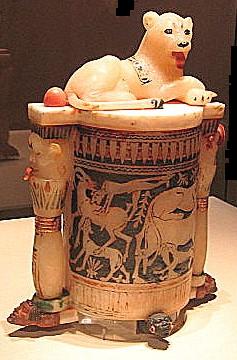Alabaster
Alabaster is a fine-grained, translucent form of gypsum, a mineral composed of calcium sulfate dihydrate. It has been used throughout history for sculpture and building decoration due to its workability and attractive appearance. Alabaster is typically white or lightly tinted, often with natural veins running through it that add to its decorative appeal. This material should not be confused with calcite alabaster, also known as onyx-marble, Mexican onyx, or Egyptian alabaster, which is a carbonate mineral. The two types of alabaster have similar appearances but differ in their physical and chemical properties; gypsum-based alabaster is softer and can be scratched with a fingernail, whereas calcite alabaster is harder.
History[edit | edit source]
Alabaster has been valued as a material for art and architecture for thousands of years. The ancient Egyptians used it for making statues, vases, and other artifacts. In medieval Europe, it was commonly used for religious sculptures and altarpieces. The use of alabaster declined in the Renaissance period, but it saw a resurgence in the 19th century with the Gothic Revival and Arts and Crafts movements.
Extraction and Processing[edit | edit source]
Alabaster is quarried in various parts of the world, including Spain, Italy, Egypt, and the United States. The extraction process involves careful removal of the alabaster from the earth to prevent damage to the stone. Once extracted, the alabaster is cut into blocks or slabs and then further processed into the desired shape for use in sculptures, tiles, or other decorative elements.
Properties and Uses[edit | edit source]
Due to its softness and workability, alabaster is particularly suited for detailed carving. It has been used for both small-scale sculptures and large architectural elements. In addition to its use in art and architecture, alabaster is also used for making ornamental objects such as lamps, vases, and jewelry. Its translucency allows for the passage of light, making it an attractive material for lampshades and other lighting fixtures.
Conservation[edit | edit source]
Alabaster is susceptible to weathering and can dissolve in water, making it vulnerable to damage when exposed to the elements. Conservation efforts for alabaster artifacts and structures typically involve protecting them from moisture and pollutants. In some cases, damaged alabaster can be restored through careful cleaning and repair.
Cultural Significance[edit | edit source]
Alabaster holds cultural significance in many societies. In ancient Egypt, it was associated with the goddess Bastet and was used to make canopic jars and other items for burial rites. In the Christian tradition, alabaster boxes were purportedly used to hold precious ointments and perfumes.
Search WikiMD
Ad.Tired of being Overweight? Try W8MD's physician weight loss program.
Semaglutide (Ozempic / Wegovy and Tirzepatide (Mounjaro / Zepbound) available.
Advertise on WikiMD
|
WikiMD's Wellness Encyclopedia |
| Let Food Be Thy Medicine Medicine Thy Food - Hippocrates |
Translate this page: - East Asian
中文,
日本,
한국어,
South Asian
हिन्दी,
தமிழ்,
తెలుగు,
Urdu,
ಕನ್ನಡ,
Southeast Asian
Indonesian,
Vietnamese,
Thai,
မြန်မာဘာသာ,
বাংলা
European
español,
Deutsch,
français,
Greek,
português do Brasil,
polski,
română,
русский,
Nederlands,
norsk,
svenska,
suomi,
Italian
Middle Eastern & African
عربى,
Turkish,
Persian,
Hebrew,
Afrikaans,
isiZulu,
Kiswahili,
Other
Bulgarian,
Hungarian,
Czech,
Swedish,
മലയാളം,
मराठी,
ਪੰਜਾਬੀ,
ગુજરાતી,
Portuguese,
Ukrainian
Medical Disclaimer: WikiMD is not a substitute for professional medical advice. The information on WikiMD is provided as an information resource only, may be incorrect, outdated or misleading, and is not to be used or relied on for any diagnostic or treatment purposes. Please consult your health care provider before making any healthcare decisions or for guidance about a specific medical condition. WikiMD expressly disclaims responsibility, and shall have no liability, for any damages, loss, injury, or liability whatsoever suffered as a result of your reliance on the information contained in this site. By visiting this site you agree to the foregoing terms and conditions, which may from time to time be changed or supplemented by WikiMD. If you do not agree to the foregoing terms and conditions, you should not enter or use this site. See full disclaimer.
Credits:Most images are courtesy of Wikimedia commons, and templates, categories Wikipedia, licensed under CC BY SA or similar.
Contributors: Prab R. Tumpati, MD





